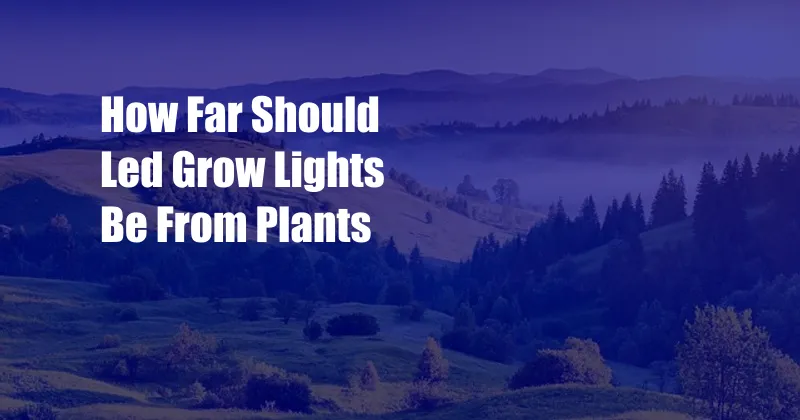
How Far Should LED Grow Lights Be From Plants?
When it comes to indoor gardening, the placement of LED grow lights is crucial in optimizing plant growth and yield. The distance between the lights and the plants plays a vital role in determining the intensity and distribution of light that reaches the canopy. In this article, we will delve into the optimal distance between LED grow lights and plants, exploring its significance and providing practical tips for your indoor gardening setup.
In the realm of artificial lighting, LED grow lights have emerged as a highly efficient and cost-effective solution for indoor cultivation. These lights emit targeted wavelengths of light that are specifically beneficial for plant growth, promoting photosynthesis and other essential processes. Understanding the appropriate distance between LED grow lights and plants is key to maximizing their effectiveness and achieving optimal plant health.
Distance Matters: Intensity and Distribution
The distance between LED grow lights and plants directly affects the intensity and distribution of light that reaches the canopy. Light intensity, measured in units of PAR (Photosynthetic Active Radiation), refers to the amount of light energy available to plants for photosynthesis. Too little light can lead to stunted growth and low yields, while excessive light can cause stress or even damage to plants.
The distribution of light, on the other hand, determines how evenly light is distributed throughout the canopy. Uniform light distribution ensures that all plant parts receive sufficient light for optimal photosynthesis. Uneven distribution can result in shaded areas and reduced yields.
Optimal Distance: Striking the Balance
To achieve both optimal light intensity and distribution, the distance between LED grow lights and plants should be carefully considered. As a general rule of thumb, here are some guidelines:
- Seedlings and Young Plants: 24-36 inches
- Vegetative Stage: 18-24 inches
- Flowering Stage: 12-18 inches
These distances ensure that plants receive adequate light intensity without experiencing excessive heat or light stress. It’s important to note that these guidelines may vary slightly depending on the specific type of LED grow lights used and the characteristics of the plants being grown.
Monitoring and Adjustment: Fine-Tuning Your Setup
Once your LED grow lights are set up, it’s crucial to monitor plant growth and make adjustments as needed. Observe your plants for signs of light stress or nutrient deficiencies. If plants appear leggy or have pale leaves, it may indicate insufficient light intensity. Conversely, if plants have stunted growth or burnt leaves, it could be a sign of excessive light intensity.
You can also use a light meter to measure the PAR levels at different heights to ensure that your lights are delivering the appropriate intensity. By fine-tuning the distance between the lights and plants, you can optimize the light environment for your indoor garden, promoting healthy growth and maximizing yields.
Expert Tips and Advice: Enhancing Your Setup
Beyond the basics, here are some expert tips and advice to further enhance your LED grow light setup:
- Use a Reflectors: Reflective materials, such as Mylar or white paint, can be used to maximize light distribution and reduce light loss.
- Adjust Height as Plants Grow: As plants grow taller, adjust the height of the LED grow lights accordingly to maintain the optimal distance.
- Consider Plant Species: Different plant species have varying light requirements. Research specific requirements to determine the appropriate distance for your plants.
- Light Cycles and Intensity: Experiment with different light cycles and intensities to find the optimal settings for your specific setup.
- Water Wisely: LED grow lights can generate heat, so adjust watering frequency accordingly to prevent overwatering.
By incorporating these tips into your indoor gardening setup, you can create an optimal environment for your plants to thrive. Remember, the key is to monitor your plants closely and make adjustments as needed to ensure their health and productivity.
FAQs: Addressing Common Concerns
Here are some frequently asked questions regarding the distance between LED grow lights and plants:
Q: Can LED grow lights be too close to plants?
A: Yes, excessive light intensity can cause light stress, leading to stunted growth, nutrient deficiencies, and even leaf burn. Refer to the guidelines provided for optimal distances.
Q: What are the signs of light stress in plants?
A: Light stress can manifest in various ways, including leggy growth, pale leaves, stunted growth, and burnt or yellowing leaves.
Q: How often should I adjust the height of my LED grow lights?
A: As plants grow taller, adjust the height of the lights every few weeks to maintain the recommended distance.
Q: Do different plant species require different light distances?
A: Yes, different plant species have varying light requirements. Research specific species to determine their optimal distance from LED grow lights.
Q: Can I use a light meter to measure light intensity?
A: Yes, a light meter is a useful tool for measuring PAR levels at different heights. This can help you fine-tune your light setup and ensure optimal light intensity for your plants.
Conclusion: Optimizing Your Indoor Lighting
Understanding the optimal distance between LED grow lights and plants is essential for maximizing plant growth and yields in indoor gardening. By following the guidelines and tips outlined in this article, you can create an efficient and effective lighting environment for your plants to thrive. Remember to monitor your plants closely and make adjustments as needed to ensure their health and productivity.
Is there anything else you’d like to know about LED grow lights and plant distance? Leave a comment below and let’s continue the discussion.